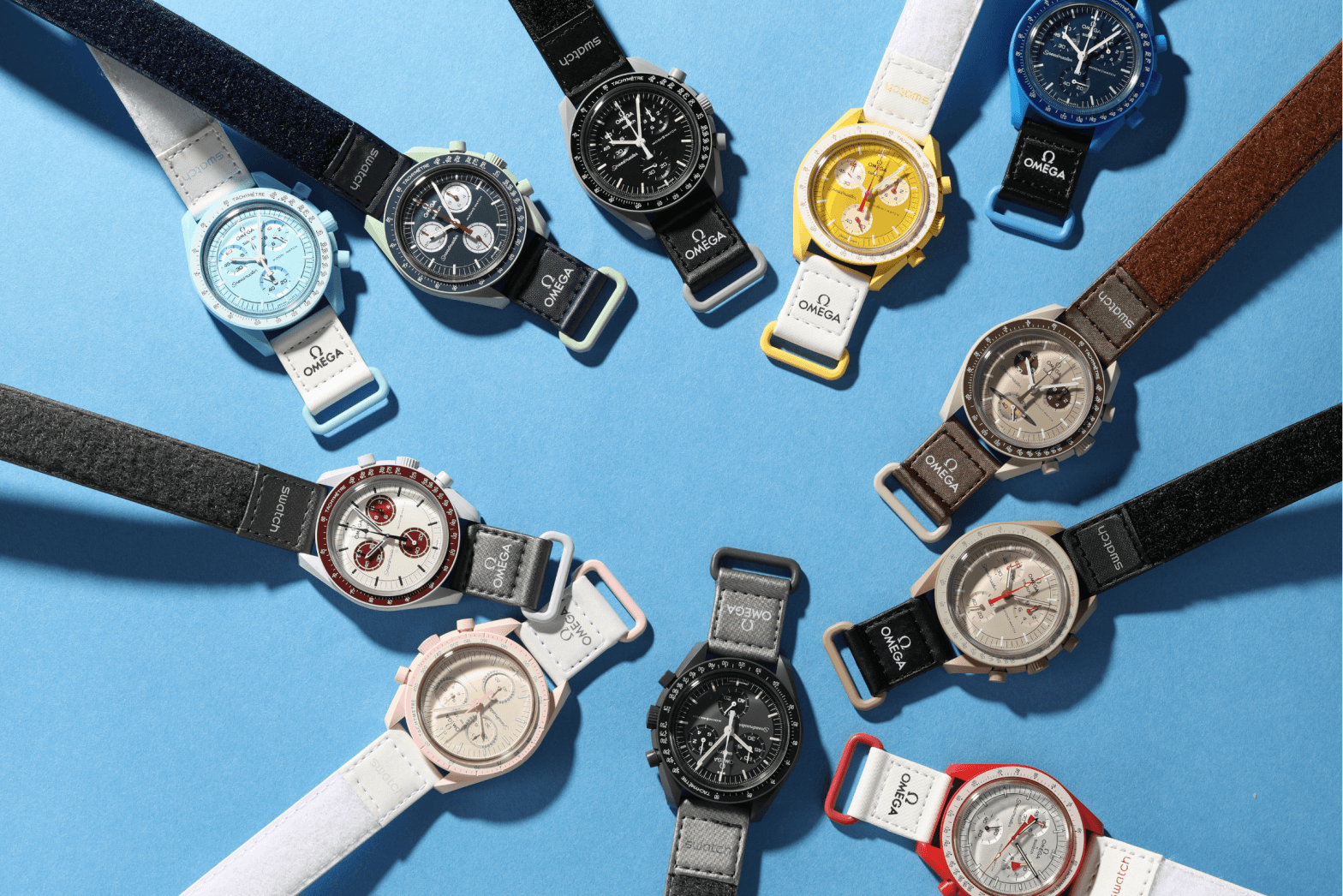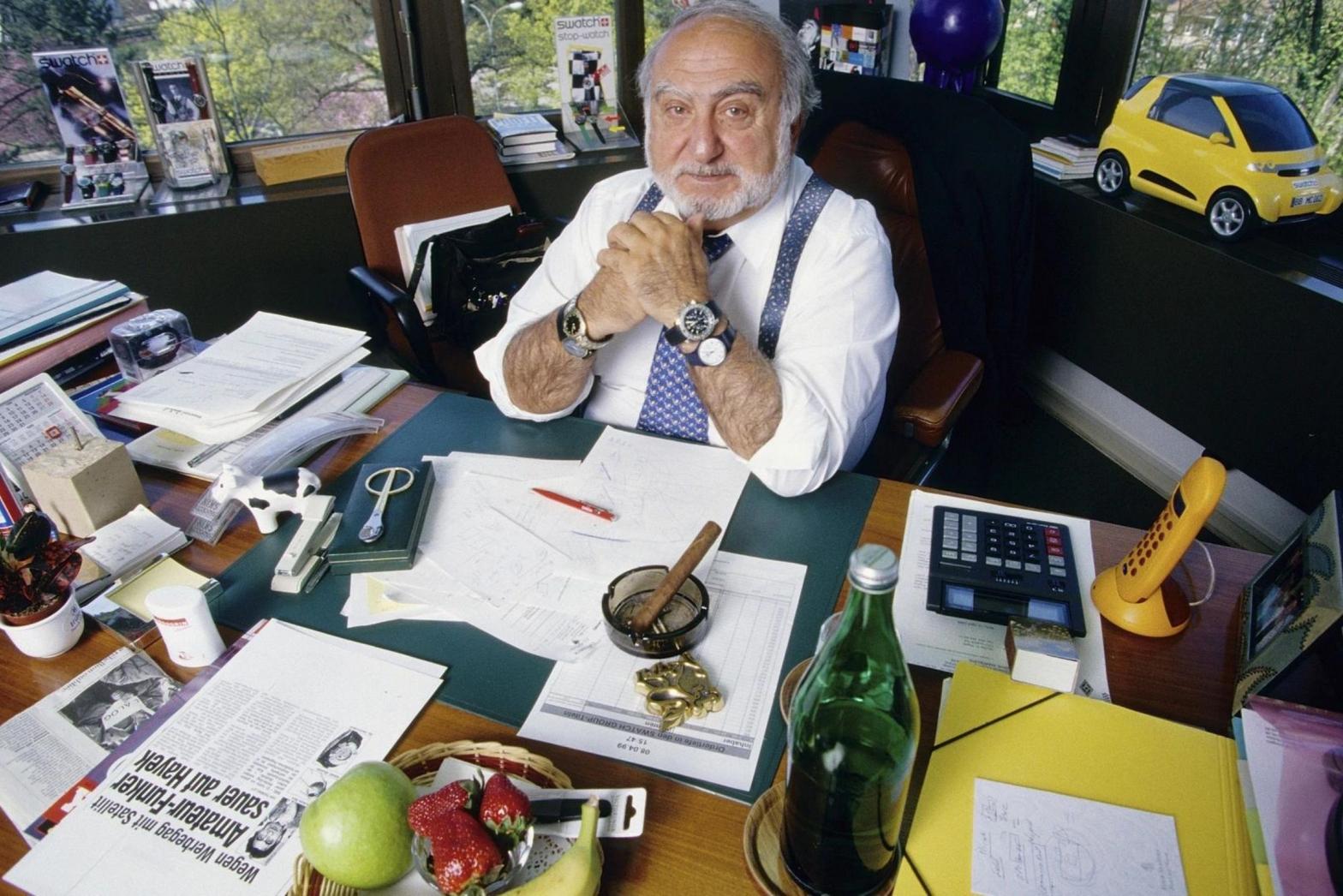
Swatch: The Brand That Dared to Embrace Art, Fashion, and the Zeitgeist
Swatch Group’s eponymous purveyor of fun-filled, affordable watchmaking has long had a knack for sending the right message - as the brand’s most recent team-up with Omega reminds us…
Earlier this March, Mark Ritson, award-winning columnist and professor of marketing, wrote an enthusiastic endorsement of the recent MoonSwatch launch - lauding it for helping Swatch generate “enormous salience, traffic, editorial and a welcome boost of premiumness thanks to its proximity to Omega”.
In the months since, journalists and insiders have speculated about what sort of effect, going forward, the collaboration between two of Swatch Group’s biggest brands might have on the vaunted Speedmaster; but what makes Ritson’s analysis so incisive is how he considered this exercise in crossover branding largely through the prism of Swatch. The takeaway? No matter how things shake out for Omega, its egalitarian sister brand has clinched a major victory. “[Swatch] makes good-value, long-lasting, fun watches and not enough people know that,” says Ritson. Thanks to the feeding frenzy surrounding the MoonSwatch, it’s a safe bet consumers are again paying close attention.
The success of this collaboration - part of a select few in the watch industry which have managed to tap what T. Blackett dubbed the ‘science of alliance’ - raises further discussions about Swatch’s modern history. Having been more or less responsible for promulgating the concept of ‘watches as fashion’, the MoonSwatch definitely isn’t Swatch’s first foray into bringing horological culture to the masses. Before diving into the minutiae of what makes this such an enviable case study for marketers everywhere, we thought it best to start at the beginning: before Swatch and its ineffable brand of wearable culture had yet to dominate the globe.

Fantastic Plastic: The Creation of Swatch
With the wisdom of hindsight, it’s amusing to think that the initial Swiss solution to the Quartz Crisis was to double down on high-end quartz. Though they were impressive engineering feats, early attempts to make a quartz luxury watch (e.g. Beta 21) proved commercially lukewarm; and it wasn’t until SMH, precursor to Swatch Group, was formed that a strategy to democratize this technology hove into view.

Following a dramatic dive in exports between 1977-1983 - caused by the rocketing popularity of electronic Japanese watches - Swiss brands were scrambling to save themselves from extinction. Among the biggest of these were SSIH, owners of Omega and Tissot; and ASUAG, parent to movement manufacturing giant ETA. In 1983, the two companies completed one of the biggest mergers in the industry’s history, orchestrated by Mr. Nicolas Hayek - by trade, an engineering consultant who would eventually become Swatch Group’s Chairman.

As it turns out, the alliance Hayek brokered had a Lazarian effect. Not least because in acquiring ASUAG, SMH gained access to technologies pioneered by Dr. Ernst Thomke - an individual Swatch fans regard as a household name. During his tenure as ETA’s CEO, Thomke had already been investing heavily in the development of injection moulds: a manufacturing process that made it possible to produce watch cases out of monobloc plastic, on an industrial scale. It didn’t take long for Hayek to recognize this technology’s potential. Early versions of the now-iconic Swatch contained a mere 51 parts, immediately improving upon the lead times and material cost previously associated with Swiss-made quartz.
Thanks to their simple self-contained construction, these could be made in record numbers. For a 9-year period beginning in 1983 (when Swatch was officially established) the company manufactured 100 million units - a frankly staggering quantity that helped close the gap with Japanese electronics behemoths like Casio and Citizen.
A Whole Mood: Popular Culture, America, and the Rise of ‘Fashion Watches’
By the mid-1980s, Hayek and the SMH brain trust had successfully paved the way for Swatch’s burgeoning brand. Ad campaigns with taglines like “crazy new wave” and “Granita di Frutta” caught the interest of teens, with many able - for the first time - to buy an affordable Swiss-made timepiece. Unlike ‘serious’ brands within SMH, Swatch also chose to eschew trade-show publicity: instead, launching new products every season (in a manner redolent of the fashion industry).

Swatch’s alignment with all things à la mode in pop culture became especially apparent under the leadership of Max Imgruth. Hayek’s mirror image, Imgruth had originally been a marketing consultant at SSIH during the company’s pre-merger days. In 1983, he was chosen to spearhead Swatch’s business in the US - taking the company from, in just two short years, from sales of $3 million to $135 million. When asked by American journalists to explain how he’d managed to deliver this miracle, Imgruth’s answer was deceptively simple. “What we’re marketing is much more of a lifestyle,” he said, “[it’s] an idea, rather than something that just ticks”.
An important part of Imgruth’s strategy was to pitch Swatch to market segments traditionally considered a non-starter for luxury watch brands. That necessarily included the aforementioned teen demographic, who, as Felix Scholz, Co-Host of OT: The Podcast can personally attest to, latched on all around the globe. “I was a child for the 1980s and much of the 1990s. I can’t speak to a specific ‘moment’ when Swatch entered the zeitgeist, but what I do recall was just how cool [the brand] was,” says Scholz. “My brother had a large wall clock and would buy multiple Swatch watches every year. Rather than having a single partnership that stands out, what I’ve always been most impressed by is the breadth of the offering. From the Olympics to Vivienne Westwood, Swatch’s cultural reach is immense.”
_0.gif&w=4320&q=75)
In a move that would later be replicated worldwide, Imgruth also made a concerted effort to advertise Swatch’s wares to female customers aged 12-24. Swatches were pitched with the same trendy aura as a pair of Reebok sneakers or Levi’s denim. Crucially, each campaign’s tone of voice was friendly and informal: with themes of matrimony, motherhood and physical objectification largely absent from the advertisements of this era.
The reality is that, when it comes to inspiration, Swatches are among the most eclectic objects ever to spring forth from the watch industry. Whether inadvertently or by design, their injection-moulded cases and open dials make for an ideal canvas on which cultural events of our lifetime are recorded: explaining why they’ve been the medium of choice for dozens of 'artist specials’ since 1985.
Focal points in this collecting niche include the 140-piece Kiki Picasso run and Italian sculptor Mimmo Paladino’s ‘Oigol Oro’ design. Unfettered by the constraints placed upon traditional watch brands, Swatch even tried its hand at a series of horological lunchables - designed by Austrian painter Alfred Hofkunst. Inspired by pop art of the late 1980s, Hofkunst’s creations have won applause from a range of (often surprising) quarters. Tom Chng, high-powered co-founder of Singapore Watch Club, is one such unlikely proponent. “The 1991 ‘One More Time’ set is, to me, the stand-out,” says Chng. “Originally unveiled at specialty grocers, it’s an insanely wacky way to conceptualize, execute and distribute wristwatches. Along with Hofkunst, [Swatch] succeeded in making something fun that stands as a democratization of time.”

One small step for Swatch…a giant leap for Swatch Group
Unbelievable though it may seem - considering what we know of Swatch’s 30-year history - the recent MoonSwatch unveiling does indeed break new ground for the brand (if not the entire industry). Surprisingly, this marks the first occasion on which Swatch and Omega have collaborated on a single product and, unlike most co-branded luxury in the 21st century, was never meant to be a limited edition.
Currently, it remains too early to tell whether the launch will have the long-term ‘cannibalizing’ effect on the Speedmaster that doomsayers seem so worried about. But, if current data is to be believed, the reality is just the opposite. According to Ritson, stats from the March launch weekend alone indicated Swatch “sold almost certainly more MoonSwatches in a single morning than Omega will sell Speedmasters all year”.
At one-tenth the price of Omega’s baseline Speedmaster Professional, detractors have argued this is a bubble born out of economic convenience, though it’s unlikely Swatch Group’s biggest player (by market share) would commit themselves to crossover play without having first considered the big picture. Put another way, Swatch Group executives have calculated the damage to the Speedmaster’s mindshare shall largely be imagined - a sentiment articulated by Raynald Aeschlimann, CEO of Omega, right from the get-go. “There is a vast space between a genuine Speedmaster MoonSwatch and this Swatch,” Aeschlimann said in an interview with Wired earlier this year. “There’s really no crossover in any true sense, apart from the look.”
Those comments reveal the calculated gamble at the heart of the MoonSwatch - one that, if correctly adjudged, will be recorded in the history book of genius marketing manoeuvres. In July, reporting by Bloomberg UK indicated that sales of the Speedmaster Professional had “increased by more than 50 percent since the launch of the $250 MoonSwatch in March”.
That news has been an early coup for perceptive execs like Aeschlimann who, as Scholz points out, know the importance of seeding the next generation of watch consumers. Many of whom, until now, might have proved resistant to traditional marketing narratives. “Major fashion houses know that getting younger people with less spending power to ‘buy into’ your brand is a worthwhile investment,” Scholz says. “Look at the Balenciaga cap or Loewe’s elephant charms - done correctly, this sort of purchase can kickstart a lifetime of positive brand associations. The MoonSwatch is no different.”
